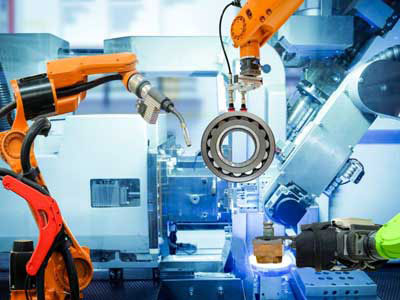Key Takeaway
Industrial robots typically use lithium-ion batteries due to their lightweight, high energy density, and quick recharge capability. These batteries are reliable and efficient, making them ideal for robotic applications. Leading manufacturers of lithium-ion batteries include LG Chem, Samsung SDI, and Panasonic. Additionally, some robots use other power sources like nickel-metal hydride (NiMH) and lead-acid batteries, depending on the specific requirements and operating conditions. However, lithium-ion remains the preferred choice for most industrial robots due to its superior performance and efficiency.
Traditional Power Sources
Traditional power sources typically refer to non-renewable energy forms such as coal, natural gas, and nuclear energy. These sources have long been the backbone of global energy production due to their reliability and high energy density. However, concerns over environmental impact, finite resources, and sustainable energy practices have prompted a shift towards cleaner alternatives like solar, wind, and hydroelectric power. Despite this trend, traditional sources still dominate global energy markets, albeit with increasing emphasis on efficiency and emission reduction technologies.

Battery Technologies
Battery technologies have evolved significantly, providing a more flexible power solution for industrial robots. Lithium-ion batteries are currently the most popular choice due to their high energy density, long life cycle, and relatively low maintenance requirements. These batteries allow robots to operate wirelessly, offering greater mobility and versatility. This is particularly useful in manufacturing applications where robots need to navigate complex environments without the constraint of power cords. Another emerging technology is solid-state batteries. These promise even higher energy densities and faster charging times compared to traditional lithium-ion batteries. Although still in development, solid-state batteries could revolutionize how industrial robots are powered in the near future.
The ability of lithium-ion batteries to support high energy output while maintaining a compact size makes them ideal for industrial robots. They ensure longer operational times, reducing the need for frequent recharges and increasing productivity. Solid-state batteries, on the other hand, are expected to address some of the current limitations of lithium-ion batteries, such as safety concerns and limited lifespan. With advancements in battery technology, industrial robots will become more efficient and versatile, capable of performing complex tasks with greater precision and reliability. As battery technology continues to evolve, the future of industrial r
Energy Efficiency Solutions
Energy efficiency is a critical consideration for industrial robots. Implementing energy-efficient solutions not only reduces operational costs but also extends the lifespan of the robots. One effective strategy is regenerative braking, which recovers energy that would otherwise be lost during braking and redirects it back into the system. This technology is already used in electric vehicles and is gaining traction in industrial robotics. By harnessing this energy, robots can operate more efficiently, conserving power and reducing the need for frequent recharges.
Another solution is the use of advanced power management systems. These systems optimize energy usage by controlling the power distribution within the robot, ensuring that only the necessary amount of energy is consumed at any given time. This not only conserves energy but also enhances the overall performance and efficiency of the robots. Implementing these energy-efficient technologies can lead to significant cost savings and improved operational efficiency. As the demand for sustainable and cost-effective solutions grows, energy efficiency will play a crucial role in the future of industrial robotics.
Renewable Energy Integration
As sustainability becomes a growing concern, integrating renewable energy sources into industrial robotics is gaining momentum. Solar power is a viable option for robots operating in environments with abundant sunlight. Solar panels can be installed on the robots or within the facility to provide a supplementary power source. This not only reduces the reliance on traditional power sources but also lowers the overall carbon footprint of the operations. Wind energy is another potential renewable source. While it may not be practical for all industrial applications, facilities located in windy regions can harness this energy to power their robotic operations.
Integrating renewable energy not only reduces the carbon footprint but also ensures a more sustainable and resilient power supply. This approach aligns with global efforts to promote green technologies and reduce dependency on fossil fuels. As the technology for harnessing renewable energy sources continues to improve, the potential for integrating these solutions into industrial robotics will expand. This will lead to more environmentally friendly and sustainable manufacturing processes, contributing to the global push towards a greener future.
Future Power Innovations
The future of industrial robot power sources looks promising with several innovations on the horizon. Wireless charging technology is one such innovation. It allows robots to recharge without physical connections, reducing downtime and increasing operational efficiency. This technology can significantly improve the workflow in manufacturing environments, as robots can recharge autonomously without the need for human intervention. Another exciting development is the use of hydrogen fuel cells. These cells offer high energy density and zero emissions, making them an eco-friendly alternative to traditional power sources. Although still in the experimental stage, hydrogen fuel cells have the potential to transform the landscape of industrial robot power solutions.
Advancements in nanotechnology could also lead to the development of ultra-small, high-capacity batteries. These batteries would enable the creation of more compact and lightweight robots, expanding their applications in various industries. The combination of these innovative technologies will pave the way for more efficient, versatile, and sustainable industrial robots. As these technologies continue to evolve, they will play a crucial role in shaping the future of industrial automation, enhancing productivity, and reducing environmental impact.
Conclusion
In conclusion, the power sources and battery technologies for industrial robots are evolving rapidly. Traditional electrical connections, while reliable, are being supplemented by advanced battery technologies that offer greater mobility and efficiency. Energy-efficient solutions and renewable energy integration are paving the way for more sustainable operations. Future innovations, such as wireless charging and hydrogen fuel cells, hold the promise of even greater advancements.
By staying informed about these developments, newly joined engineers can contribute to optimizing the performance and sustainability of industrial robots, driving the future of manufacturing towards greater efficiency and innovation.
